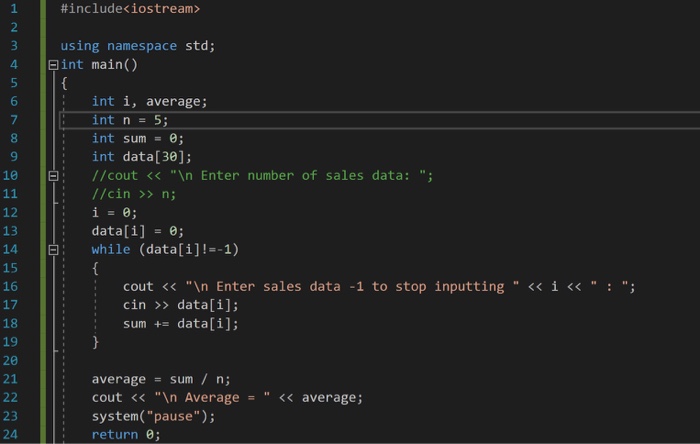The while statement is like the if statement in that it tests a condition. just like an if statement, the condition in a while statement can be an expression of any simple data type. In C++, any nonzero value is coerced to type Boolean true, and zero is coerced to type Boolean false. If the expression evaluates to false, then execution passes beyond the while loop; if it evaluates to true, than the code in the while loop executes once and then the conditional expression is once again evaluated. Each pass through the loop is called an iteration, and before each iteration there is a loop test.
C provides several data types for storing floating-point numbers in memory, including float and double. The primary difference between these types is that. For example, in a sentinel-controlled loop, the prompts requesting data entry should explicitly remind the user what the sentinel value is. Sentinel controlled loop b. General conditional loop c. Counter controlled loop d. Infinite loop e. None of the above 24. The function is a built-in function that generates a list of integer values. C Programming Tutorials brought to you by TONY TUTORIALS. Question: Using A Sentinel Value To Control A While Loop Summary In This Lab, You Write A While Loop That Uses A Sentinel Value To Control A Loop In A C Program That Has Been Provided. You Also Write The Statements That Make Up The Body Of The Loop. The Source Code File Already Contains The Necessary Variable Declarations And Output Statements. Sentinel and Counter Controlled Loop in C Previously we have learned about what is the difference between Entry and Exit Controlled Loops in C? According to logic of solving the problem, we use two type of looping logics - 1) Sentinel Controlled Loop and 2) Counter Controlled Loop.

The statement or group of statements to be executed each time through the loop is known as the body of the loop. The body of the loop must be enclosed in curly braces if contains more than one statement.
The condition that causes the loop to exit is the termination condition. There are two different types of loops, depending on what constitutes the termination condition. The first type of loop is the count-controlled loop, which is a loop that executes a specified number of times. The second type of loop is the event-controlled loop, which terminates when something has occurred inside the loop body. This sort of loop is used when working with variable data, such as user input, or searching the contents of a file.
A count controlled loop uses a variable called the counter or iterator in the loop test. Before we start the loop, we must initialize the counter variable, and in each iteration of the loop we must modify the counter in some way so that it reaches a termination condition.
The loop-control condition is always a counter variable in a count-controlled loop. In our first program the counter variable is incremented by one with each iteration of the loop. We can also decrement the variable by one, or modify it in other ways.
When writing loops, we must be sure to set the condition to be tested before the while loop begins. We must also make sure that the condition changes within the loop so that it eventually becomes false, otherwise we end up with an infinite loop.
Event-controlled loops are used to read, write, and process data. Each iteration of the loop represents an action on a data object. Often when reading data either from a file or from standard input we have a sentinel or end-of-file controlled loop. The sentinel value is used to signal that there is no more data to be read or processed. Often when accepting input or reading from a file we will have a priming read, where the first set of data or input is read before entering the loop.

Often when reading data in one line at a time we can use the newline character as the sentinel.
We should mention here that cin goes into the fail state if it receives unacceptable input data. We use the cin’s fail state to kick off a set of statements to reset cin and clear the input buffer.
Note that in real life we would use cin.ignore() and not cin.get(ch) to clear the input buffer.
Like cin, input file streams go into the fail state if they try to open a file that does not exist, or if the program tries to read past the end of the file. We can, in fact, use the fail state as a sentinel when reading files.
Flag controlled loops are somewhat different than sentinel-controlled loops. A flag is a Boolean variable that is set to true before running the loop, and then can be optionally set to false to end the loop. We use the Boolean variable to record that the desired event has transpired.
C++ Sentinel Controlled Loop
Alright, well that is enough for today. If you get the chance, take a look at my Amazon.com author’s page: http://www.amazon.com/Al-Jensen/e/B008MN382O/
